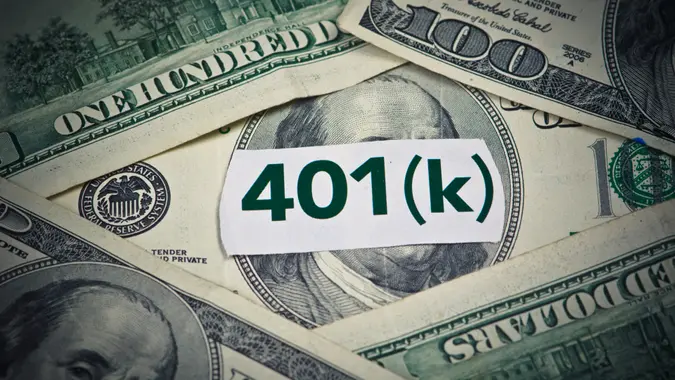Dave Ramsey’s Step-by-Step Plan for When You’re Behind on Debt and Retirement

Commitment to Our Readers
GOBankingRates' editorial team is committed to bringing you unbiased reviews and information. We use data-driven methodologies to evaluate financial products and services - our reviews and ratings are not influenced by advertisers. You can read more about our editorial guidelines and our products and services review methodology.

20 Years
Helping You Live Richer

Reviewed
by Experts

Trusted by
Millions of Readers
Most financial advice tells you to contribute to your 401(k) no matter what, especially when your employer offers matching. Dave Ramsey disagrees. The bestselling personal finance author believes if you’re drowning in debt, you need to stop all retirement investing and focus on one thing: getting out of debt completely.
Ramsey’s approach goes against conventional wisdom, but his reasoning is simple. You can’t build wealth while you’re paying interest on credit cards, student loans and other high-interest debt. His plan prioritizes behavior change and financial discipline over maximizing short-term returns.
Why Ramsey Says Pause Your 401(k)
Ramsey’s most controversial advice is stopping 401(k) contributions entirely while paying off debt, even when your employer offers matching. He acknowledged this makes people nervous.
“I’m a math nerd, and I know that getting a 100-percent match on your contributions is a sweet deal,” Ramsey shared. That said, he still believes the psychological benefits of debt elimination outweigh the missed employer match.
His strategy involves pausing retirement contributions for about 18 months to free up cash flow for aggressive debt repayment. Once you’re debt-free, you can resume investing without monthly debt payments weighing you down.
Step 1: Build a Small Emergency Fund
Before attacking debt, Ramsey recommends saving $1,000 for emergencies. This prevents you from going deeper into debt when unexpected expenses hit.
The emergency fund isn’t meant to cover major emergencies like job loss or medical bills. It’s designed to handle smaller unexpected costs like car repairs or appliance replacements that might otherwise force you to use credit cards.
This step should happen quickly. Sell stuff, pick up extra work or cut expenses temporarily to get that $1,000 saved as fast as possible.
Step 2: Use the Debt Snowball Method
Ramsey’s debt elimination strategy focuses on behavior over mathematics. List all your debts except your mortgage from smallest balance to largest, regardless of interest rates.
Pay minimum payments on everything, then throw every extra dollar at the smallest debt until it’s gone. Once the first debt disappears, take that payment amount and add it to the minimum payment of the next smallest debt.
This creates momentum as debts disappear one by one. The psychological wins from eliminating smaller debts first help people stay motivated through the process, even if it means paying slightly more interest overall.
Step 3: Resume Retirement Investing Only After Debt Freedom
Ramsey defines debt freedom as having no payments except your mortgage. Home loans are acceptable because real estate builds equity, unlike credit cards or car loans that lose value.
Only after eliminating all non-mortgage debt should you resume 401(k) contributions and other retirement investing. At this point, you have the full power of your income available for building wealth instead of servicing debt.
This is when Ramsey recommends getting aggressive with retirement savings, typically suggesting 15% of income toward retirement once you’re debt-free.
The Philosophy Behind the Plan
Ramsey’s approach prioritizes financial behavior change over mathematical optimization. He believes people struggling with debt need structure and discipline more than they need to maximize every dollar of potential returns.
“Your financial security in retirement shouldn’t come from Social Security — it should come from what you’ve saved over your working lifetime,” Ramsey explained. “You are the CEO of your retirement.”
His method addresses the psychological aspects of money management. Many people feel overwhelmed trying to balance debt payments and retirement contributions simultaneously. Ramsey’s sequential approach provides clarity and focus.
When This Plan Makes Sense
Ramsey’s strategy works best for people with high-interest debt who struggle with financial discipline. If you have credit card debt at 20% interest rates, it’s mathematically impossible to invest your way out of that hole.
The plan also appeals to people who feel overwhelmed by competing financial priorities. Having a clear sequence of steps removes the paralysis of trying to optimize everything at once.
People with variable income, like commission-based workers or small-business owners, often find this approach helpful because it creates a stable foundation before adding investment complexity.
When You Might Consider Alternatives
Ramsey’s plan isn’t for everyone. If you have low-interest debt (say, a 3% student loan) and your employer offers generous 401(k) matching, you might come out ahead by contributing enough to get the full match while paying minimums on low-interest debt.
High earners with major tax benefits from retirement contributions might also take a more modified stance by balancing debt repayment with some retirement investing.
The key is, as always, being honest about your financial discipline. If you can consistently manage multiple financial goals simultaneously, you might not need Ramsey’s all-or-nothing approach.
 Written by
Written by  Edited by
Edited by 


























